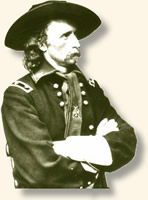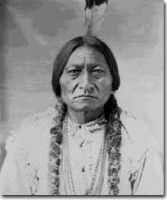
General George Custer

Sitting Bull
 General George Custer |
 Sitting Bull |
Battle of the Little Big Horn
|
|
| The most famous Indian battle in
American history is the Battle of the Little Big Horn, also known as
Custer's Last Stand. Depicted in films and novels, the battle at the Little Big Horn River, located in what is now Montana, proved to be the death of U.S. Army General George Armstrong Custer and 265 men from his Seventh Cavalry Regiment. Custer had been part of an army campaign to force Sioux and Cheyenne Indians off the plains and into the reservations. Gold had been found on Indian lands in South Dakota's Black Hills and now white men wanted that land for themselves. Indians were ordered off the lands but, refusing to leave, took to the warpath. Going into the Black Hills, Custer had been warned that 2,000 to 4,000 Sioux and Cheyenne Indians were waiting there for him. Instead of a surprise attack, Custer led a full charge straight into the area. He met thousands of Indians, led by Chief Sitting Bull and Crazy Horse, who closed off Custer's retreat. Only a half-Indian scout for Custer's group survived the battle; Custer and all his men died. Back on the East Coast, newspapers interpreted the battle as a savage Indian attack on innocent Army personnel. The public responded by demanding war on the Sioux and soon the Army launched more ferocious attacks on the Indians. David's Note: Here is a more detailed narration on the battle provided by Phil Logan, Custer Partisan Custer did not receive precise intelligence that the Indian village was as large as it was. As far as his strategy was concerned in the past when confronting Indians they avoided direct engagements with Army troops. The Indians would scatter in several different directions making the pursuers waste their time chasing smaller elements. Custer's tactic was to hit a village at dawn from three sides blocking any escape. This tactic was successful at the Washita river engagement in 1868. This is the manner it which he attacked the village at the Little Big Horn. Custer had planned to wait until dawn to strike the Indian camp on the 26th. However, word had arrived that the command may have been discovered and the secrecy blown. Thus Custer to prevent the Indian camp from breaking up and scattering ordered the 7th Cavalry to prepare to attack the camp immediately. Prior to the attack Custer divided his command into 4 elements. One element was a company securing the pack train; one battalion under Captain Frederick Benteen and a battalion commanded by Major Marcus Reno. The last battalion was commanded by Custer personally. Custer sent Benteen to scout around to the rear of the village. Reno's command would directly assault the village and Custer's command would support him. The last time Custer was seen alive was when he was seen Reno's battalion as they advanced to the Indian camp. Unfortunately, Reno's assault on the village faltered almost immediately. Rather than charge the village he threw out a skirmish line. This allowed the Indians time to regroup and attack Reno's men. Reno panicked and gave several quick contradictory orders. Thus followed a route to escape from the Indians which the Indians later characterized as a "buffalo hunt." Reno finally secured a fighting position on the bluffs and stayed there surrounded by the Indians. Custer it appears attempted to find areas to cross the big horn river and out flank the village. At some point Custer sent a message to Benteen via one of his orderlies who could barely speak English. The message stated "Come on. Be quick. Big Village. Bring Packs. Custer P/S Bring Packs!" Instead of immediately rushing to Custer's support Benteen slowly turned his command around and even halted his command to allow the horses to drink. Benteen next found Reno's besieged command and rather obey his orders joined Reno in his positions. Meanwhile Custer was forced on to the defensive and wiped out. Thus, Custer's attack at the Little Big Horn can be seen as something much more than as a reckless attack against superior numbers. |
Nation Visitors Since March 8, 2013